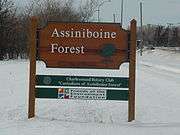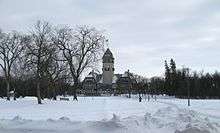Assiniboine Park
| Assiniboine Park | |
|---|---|
|
Assiniboine Park Pavilion | |
| Location | Winnipeg, Manitoba |
| Coordinates | 49°51′46″N 97°14′40″W / 49.86278°N 97.24444°WCoordinates: 49°51′46″N 97°14′40″W / 49.86278°N 97.24444°W |
| Area | 1,100 acres (450 ha) |
| Created | 1904 |
| Open | 1909 |
Assiniboine Park (formerly known as City Park[1]) is a park in Winnipeg, Manitoba. The Winnipeg Public Parks Board was formed in 1893, and purchased the initial land for the park in 1904. Although in use before then, the park officially opened in 1909, and is located north of the Assiniboine Forest, along the Assiniboine River.[2] It is named for the Assiniboine people. The park covers 1,100 acres (450 ha), of which 400 acres (160 ha) are designed in the English landscape style.
The park includes the 700-acre (280 ha) Assiniboine Forest, Assiniboine Park Zoo, Assiniboine Park Conservatory, the historic Assiniboine Park Pavilion, formal and informal gardens, a sculpture garden, a miniature railway, an outdoor theatre for performing arts, and numerous other attractions.

Prominent attractions
Conservatory and gardens
One of the earliest park features and a major indoor attraction, The Conservatory is a botanical garden housing more than 8,000 flowers, plants and trees that are non-native to Manitoba, but which grow profusely under the ideal conditions created in the Palm House and Display Garden. The original Palm House was erected in 1914, and in 1968 a fully modern structure was built over and around the Palm House, enclosing it.
Known throughout North America for its luxuriant display of thousands of annual and perennial flowers, the English Garden (established between 1926 and 1927) contains nearly three acres of flowers, shrubs and trees arranged in the traditional English style. From the outset, the English Garden was designed to serve as a popular park attraction where local residents and tourists could obtain information about specialized floriculture in Manitoba. New plant varieties have been introduced annually. A large rose garden (with more than 400 bushes (there are only a few remnants of roses in this area.) of Floribunda, Grandiflora and Rugosa varieties), broken into four sections, surrounds a central, fish-filled lily pond. (No roses exist in this area, the central pond has a large fountain in it, no fish or lilies exist.)
The Conservatory and English Garden are open free of charge to the public every day of the year.
The Formal Garden, located at the southeast park entrance,[3] was designed in 1907 by Frederick Todd as part of the original park. It features flower beds in sharply defined geometric shapes that stand out from the grassy areas. Each of the beds, as well as the overall design, is symmetrical.[4]
The Leo Mol Sculpture Garden displays more than three hundred works by Dr. Leo Mol, including bronze and ceramic sculptures, paintings and drawings. Opened in 1992, the sculpture garden has been expanded twice since.[5]
Pavilion, theatre and zoo
The park's signature feature, the Assiniboine Park Pavilion became a focus of early Winnipeg's social life. Originally designed by John D. Atchison and built in 1908, it included a dance hall, a banquet hall, lunch and catering. The 90-foot (27 m) tower contained the pump and water tower for the park's water system. It was destroyed by fire in May 1929. The current larger pavilion was designed by architects Northwood and Chivers, and was opened in May 1930. It is today one of Winnipeg's most familiar landmarks.[2]
The Lyric Theatre is a large outdoor stage located next to the Pavilion. Opened in 1999, it carries on the tradition of bandshell entertainment near the Pavilion that started in the 1920s.
The 90 acres (36 ha) Assiniboine Park Zoo is at the western end of the park just North of the main parking area,[3] and is home to over 300 animal species.
Other
Toward the north of the park, and just to one side of the pedestrian footbridge from Portage Avenue is the serpentine Duck Pond.
Adjacent to Roblin Boulevard, the last steam locomotive to run scheduled service in Canada, CNR 6043, Class U-1-d, 4-8-2, is on permanent display courtesy of the Winnipeg Railway Museum. A 2 ft (610 mm) narrow gauge[6] railway named Assiniboine Park Railroad operates in one section of the park, which features a working steam locomotive made by Crown Metal Products. Additionally, a private ridable miniature railway named the Assiniboine Valley Railway, with a track gauge of 7 1⁄2 in (190.5 mm), is located outside the park near the zoo.
The park also includes picnic areas.
Sports
The park offers playgrounds, a bicycle path, baseball and cricket fields with three cricket pitches (upper and lower grounds) and a clubhouse on site. The park is the Manitoba Cricket League’s premier facility for hosting club cricket. (Turf wickets are going to be installed on the cricket field and used for the Under-19 Cricket World Cup in 2012).
The Terry Fox Fitness Trail, dedicated to the Canadian humanitarian's memory, is designed for disabled and non-disabled individuals alike. Assiniboine Park is wheelchair-accessible.
Assiniboine Park Riparian Forest Project
The Assiniboine Park Riparian Forest Project strives to help the riparian forest bounce back from heavy use and enhance the recreational trail experience. The ongoing riverbank restoration project, begun in 2006, continues each summer.
The project concerns the strip of forest along the Assiniboine River within Assiniboine Park, a well-known and much-loved recreational area just east of the footbridge on the south side of Portage Avenue. Over many years, the forest has suffered a loss of vegetation due to flooding, invasive plant species that replace native species, and trampling from recreational activities such as hiking and biking. Generations of heavy usage has resulted in the creation of an extensive trail network, soil compaction and large areas of bare ground.
Restoration is underway in the forest through careful planning, cooperation from trail-users and efforts such as tree planting, invasive species removal and creating a main trail. The project's aim is that by reducing the impact of recreation in the forest, this natural area will still be around for generations to enjoy 100 years from now.
Gallery
- Assiniboine River
- Assiniboine Park Pavilion
 Assiniboine Park in Winter
Assiniboine Park in Winter- Leo Mol Sculpture Garden in Assiniboine Park
- Leo Mol Sculpture Garden in Assiniboine Park
- Tulip Festival 2009 in Sculpture Garden, Assiniboine Park
- Leo Mol Sculpture Garden in Assiniboine Park
- Leo Mol Sculpture Garden in Assiniboine Park
- Leo Mol Sculpture Garden in Assiniboine Park
 The Assiniboine Park Pavilion as seen from the south.
The Assiniboine Park Pavilion as seen from the south.
See also
References
- ↑ "University of Alberta Libraries". http://peel.library.ualberta.ca/postcards/PC002125.html. External link in
|website=(help); - 1 2 "Assiniboine Park Pavilion" (PDF). winnipeg.ca. Winnipeg Historical Buildings Committee. 30 January 1982. pp. 1–2. Retrieved 6 June 2015.
- 1 2 "Assiniboine Park Map" (PDF). assiniboinepark.ca. Assiniboine Park Conservancy. Retrieved 6 June 2015.
- ↑ "Formal Garden". assiniboinepark.ca. Assiniboine Park Conservancy. Retrieved 6 June 2015.
- ↑ "Leo Mol, Winnipeg sculptor, dies at 94". CBC News. 6 July 2009. Retrieved 23 October 2012.
- ↑ Surviving Steam Locomotives in Manitoba
External links
| Wikimedia Commons has media related to Assiniboine Park. |